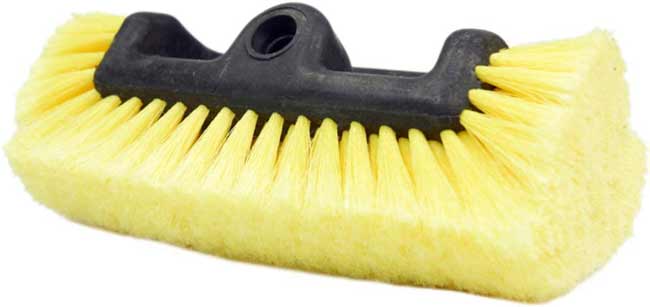The garage door is one of the largest exterior design elements that shapes a home’s appearance, and it’s something guests or potential buyers are sure to notice right away. Maintaining it in a clean and well-kept condition is key to preserving a home’s aesthetic and ensuring good curb appeal, offering a glimpse of what lies beyond. In this article, we’ll explore the best cleaning tips to help you keep your garage doors looking their best.
1. Dry Brushing
Brush down the garage door when it’s dry, including the windows if there are any. Avoid using a hard bristle brush, as it may scratch the paint or finish.

Brushing down the door beforehand will make it easier to remove any loose dirt, debris, and grime when washing it with water.
2. Sponge and Water
Avoid using strong cleaners when washing down the door. Instead, use a large, soft sponge, warm water, and diluted mild laundry detergent or diluted white vinegar. Start with the top section and then work toward the bottom, rinsing each part with your garden hose as you go along. Avoid using pressure washers. Depending on how dirty the door is, you may want to give it a second washing.
3. Cleaning Windows and Glass
After cleaning the garage door, ensure the windows are also clean and sparkling. Use a glass cleaner and a dry cloth. Keeping the garage door’s windows clean can prevent glass degradation and stains. Avoid using abrasive materials that can scratch the glass. As an extra step, use protective coatings or treatments to improve resistance to stains and degradation
4. Protecting Painted Garage Doors
To help maintain the cleanliness of the garage door for a longer period, painted garage doors can be waxed using a non-cleaning clear finishing wax. The wax provides better protection against contaminants, including abrasive dirt, as well as sunlight and UV exposure.
5. Cleaning the Garage Door from Inside
The cleaning process can be applied both inside and outside. When cleaning the garage door from the inside, ensure that you clean the safety eyes’ lenses and brush and clean the horizontal and vertical tracks of any debris and heavy-duty grease. Remove debris from the rollers, hinges, windows, and door sections. Wash the door panels only—do not wash the torsion assembly or the springs. Finally, if the garage door has been washed, dry it and lubricate the moving parts to prevent rust.
Products to Avoid When Cleaning a Garage Door
Using inappropriate products can scratch and damage the garage door paint or finish. Avoid the following when cleaning your garage door:
- High-pressure power washers.
- Abrasive materials and scouring powders.
- Paint removers and paint thinners.
- Steel wool, wire brushes, and sandpaper.
- Ammonia, bleach, and degreasers.
If you’re unsure about a product’s suitability, it’s best not to use it.
Dealing with Garage Door Imperfections
After thoroughly cleaning your garage door, you may notice deep scratches, dents, or rust on some panels caused by objects like branches. For minor paint damage, use touch-up paint to fix imperfections. Follow the manufacturer’s recommendations when applying touch-up paint. Consult a licensed garage door repair company or installer to determine the appropriate paint. Note that touched-up areas may appear shinier compared to other parts of the garage door.
Treating Rust
Garage doors exposed to water, moisture, and salty air may develop corrosion and rust. Remove rust using designated dissolvers and fine to ultra-fine sandpaper, treating only the affected area. Use delicate surface tape to isolate the rusted area, preventing damage to other parts of the garage door. Ensure complete rust removal before applying touch-up paint; otherwise, the paint will not adhere.
Regularly maintaining and cleaning garage doors can significantly extend their lifespan and preserve their aesthetic appeal. While it may seem straightforward, there are proper procedures to follow. Utilize the above methods to avoid any harmful effects. Ensure you adhere to the manufacturer’s instructions and use cleaning solutions as directed.








